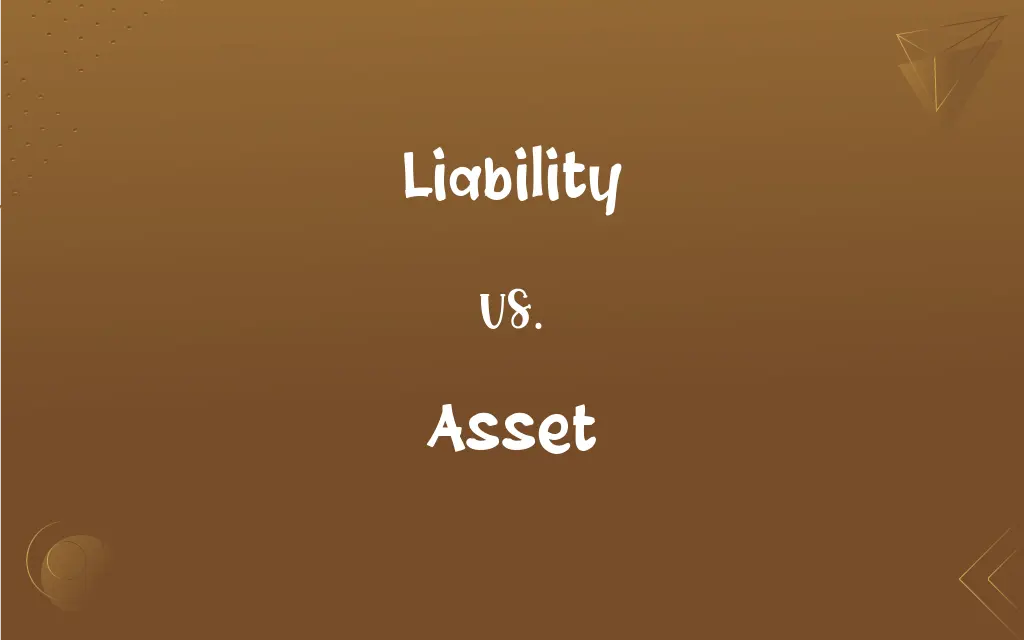Liability vs. Asset: What's the Difference?
Edited by Harlon Moss || By Janet White || Published on October 24, 2023
A liability is a financial obligation or debt owed, while an asset is a resource with economic value expected to provide future benefit.

Key Differences
Liability and asset are pivotal concepts in accounting and finance. A liability is something that is owed to another person or company, such as loans or accounts payable. It represents an obligation arising from past transactions or events, the settlement of which may result in the transfer of assets, provision of services, or other yielding of economic benefits in the future. On the contrary, an asset is a resource owned or controlled by an entity as a result of past events and from which future economic benefits are expected to flow to the entity.
Assets are essential as they have value and contribute to the overall wealth and financial stability of an individual or a company. They can be tangible, like properties and equipment, or intangible, like patents and trademarks. They are expected to provide value or generate income over time, making them critical in evaluating an entity’s financial health and potential for growth. Liabilities, however, are obligations that need to be settled, generally by transferring assets like money to the creditor, which can diminish the overall wealth and financial stability.
When assessing an entity’s financial position, both liabilities and assets play crucial roles. While assets indicate the resources that an entity possesses, liabilities highlight the obligations that the entity needs to fulfill. The difference between total assets and total liabilities gives the net worth or equity of an individual or company, allowing stakeholders to gauge the financial standing and creditworthiness of the entity in question.
The management of liabilities and assets is crucial for the financial sustainability and growth of an entity. By efficiently managing assets to generate income and strategically addressing liabilities to reduce obligations, an individual or company can optimize its financial performance and enhance its capacity to invest, grow, and meet its objectives.
Understanding the interplay between liabilities and assets is fundamental for financial planning and decision-making. By evaluating assets’ quality and liabilities’ magnitude, stakeholders, including investors, creditors, and management, can make informed decisions regarding investment, credit, and operational strategies to ensure the long-term viability and success of an entity.
ADVERTISEMENT
Comparison Chart
Nature
A financial obligation or debt owed.
A resource with economic value owned or controlled by an entity.
Impact
Reduces wealth and requires settlement.
Adds value and provides benefit or income.
Representation
Represents claims by other entities on the entity’s resources.
Represents ownership and can be used to settle liabilities.
Examples
Loans, Accounts Payable.
Cash, Equipment, Patents.
Purpose
To be settled in the future by transferring assets or services.
To be utilized to generate income and value.
ADVERTISEMENT
Liability and Asset Definitions
Liability
It represents an entity’s obligation arising from past transactions.
Unpaid bills become a liability until they are settled.
Asset
Asset is a resource with economic value.
Real estate is a tangible asset that often appreciates over time.
Liability
It is a claim on the company’s assets by external entities.
Outstanding debts are liabilities that need to be addressed promptly.
Asset
It is a valuable possession that can be converted into cash.
A savings account is a liquid asset easily accessible when needed.
Liability
Liability is a future sacrifice of economic benefits.
Accounts payable are short-term liabilities representing amounts owed to suppliers.
Asset
Asset is a resource expected to generate income.
Investment in stocks is an asset that can yield dividends.
Liability
Liability is a financial obligation or debt owed.
A mortgage is a common liability for homeowners.
Asset
A useful or valuable quality, person, or thing; an advantage or resource
Proved herself an asset to the company.
Liability
Liability is the settlement that may result in the transfer of assets.
Loans are liabilities that typically require periodic payments.
Asset
A valuable item that is owned.
Liability
The state of being liable.
Asset
A spy working in their own country and controlled by a foreign power or an enemy.
Liability
Something for which one is liable; an obligation, responsibility, or debt.
Asset
(Accounting) The entries on a balance sheet showing all properties, both tangible and intangible, and claims against others that may be applied to cover the liabilities of a person or business. Assets can include cash, stock, inventories, property rights, and goodwill.
Liability
Liabilities The financial obligations entered in the balance sheet of a business enterprise.
Asset
The entire property owned by a person, especially a bankrupt, that can be used to settle debts.
Liability
Something that holds one back; a handicap.
Asset
A thing or quality that has value, especially one that generates cash flows.
My assets consist of stocks in companies that pay a dividend, and a few apartments that pay me rental income.
Liability
Likelihood.
Asset
(accounting) Any item recorded on the left-hand side of a balance sheet.
Liability
An obligation, debt or responsibility owed to someone.
Asset
(software) Any component, model, process or framework of value that can be leveraged or reused.
Liability
(accounting) Any item recorded on the right-hand side of a balance sheet.
Asset
(espionage) An intelligence asset.
Liability
A handicap that holds something back, a drawback, someone or something that is a burden to whoever is required to take care of them; an individual or action that exposes others to greater risk.
Asset
A woman's breasts or buttocks or a man's genitalia.
Liability
A person on a team that is more of a hindrance than a help.
You're a bloody liability sometimes!
Asset
Any article or separable part of one's assets.
Liability
The likelihood of something happening.
Asset
A useful or valuable quality
Liability
The condition of being susceptible to something.
Asset
It is something owned or controlled with the expectation of future benefit.
A patent is an intangible asset providing exclusive rights to its owner.
Liability
The state of being liable; as, the liability of an insurer; liability to accidents; liability to the law.
Asset
Asset represents ownership and control.
Machinery is a fixed asset used in production processes.
Liability
That which one is under obligation to pay, or for which one is liable.
Liability
The state of being legally obliged and responsible
Liability
An obligation to pay money to another party
Liability
The quality of being something that holds you back
FAQs
Can a liability be converted into an asset?
Yes, by addressing and converting a liability efficiently, it can potentially lead to asset creation, like investing borrowed money profitably.
How does an asset provide economic benefit?
Assets can generate income, reduce expenses, or improve value, providing economic benefits to the owner.
Are assets always tangible?
No, assets can be both tangible, like property, and intangible, like intellectual property.
Can a liability have value?
While liabilities represent obligations, they can have value in strategic financing, like leveraging debts for business expansion.
Can an asset become a liability?
If an asset consistently causes financial loss or incurs expenses, it can be considered a liability in practical terms.
How are liabilities categorized?
Liabilities are typically categorized into current liabilities, due within a year, and long-term liabilities, due over a longer period.
Is deferred revenue a liability?
Yes, deferred revenue is a liability representing payment received for goods or services not yet delivered.
Can intangible assets be amortized?
Yes, intangible assets like patents and trademarks are often amortized over their useful lives.
Are all assets owned?
Assets are typically owned or controlled, but some, like leased assets, are controlled without ownership.
Is equity a liability or an asset?
Equity is neither a liability nor an asset; it represents the owner’s interest in the entity, calculated as assets minus liabilities.
How is a liability settled?
A liability is usually settled by transferring assets, like money, or providing services to the creditor.
What is the basic difference between liability and asset?
A liability is a debt or obligation owed, while an asset is a valuable resource owned or controlled.
How are assets acquired?
Assets can be acquired through purchase, lease, exchange, or by being created, like developing intellectual property.
Can a liability be intangible?
While liabilities are obligations, they are quantifiable and recorded in monetary terms, and are not classified as tangible or intangible.
Can assets have a negative value?
While assets inherently have positive value, impaired or distressed assets can have a perceived negative value due to associated liabilities or costs.
About Author
Written by
Janet WhiteJanet White has been an esteemed writer and blogger for Difference Wiki. Holding a Master's degree in Science and Medical Journalism from the prestigious Boston University, she has consistently demonstrated her expertise and passion for her field. When she's not immersed in her work, Janet relishes her time exercising, delving into a good book, and cherishing moments with friends and family.
Edited by
Harlon MossHarlon is a seasoned quality moderator and accomplished content writer for Difference Wiki. An alumnus of the prestigious University of California, he earned his degree in Computer Science. Leveraging his academic background, Harlon brings a meticulous and informed perspective to his work, ensuring content accuracy and excellence.





































































